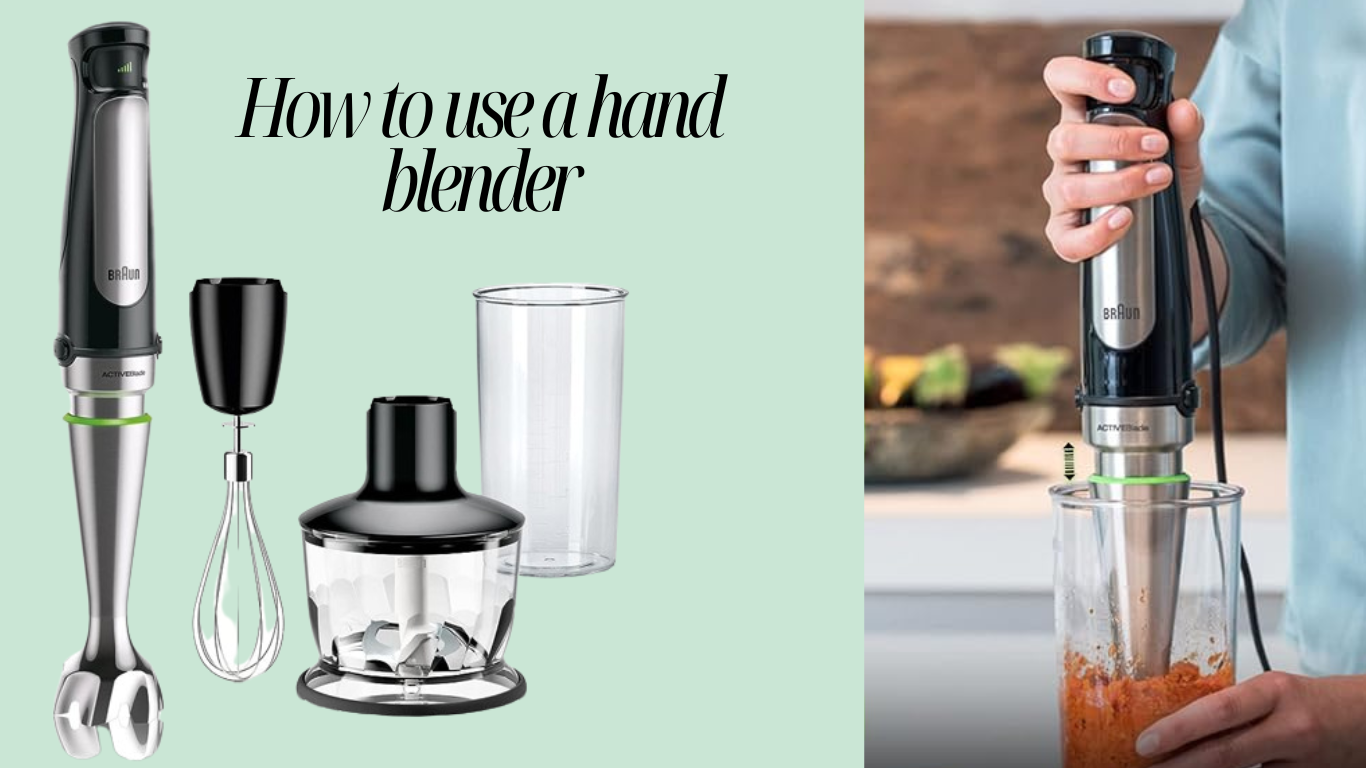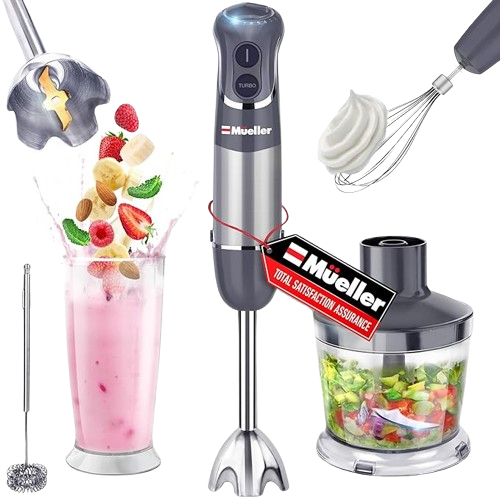Mastering the Hand Blender: A Beginner’s Guide

How to use a hand blender; Intro
Mastering the art of using a hand blender can transform your culinary endeavors, elevating your cooking to new heights of efficiency and creativity. A hand blender, also known as an immersion or, on the other hand, a stick blender, is a flexible kitchen device designed to simplify blending, pureeing, and mixing tasks. With its compact size and easy-to-handle design, a hand blender offers unparalleled convenience, making it an unquestionable
requirement for both beginner cooks and prepared culinary specialists alike. From silky smooth soups to creamy sauces and decadent desserts, the possibilities are endless once you harness the power of this indispensable appliance. In this guide, we’ll delve into the fundamentals of using a hand blender, unlocking its potential to revolutionize your culinary repertoire. click here and see more details

Ultimate Kitchen Companion: 3-in-1 Immersion Blender with Turbo Boost and Titanium Blades
Benefits of How to use a hand blender
- Efficiency: Using a hand blender streamlines your cooking process. It allows you to blend ingredients directly in the pot or container, eliminating the need for transferring hot liquids to a traditional blender. This saves time and lessens the risk of spills or accidents.
- Versatility: A hand blender is a multi-functional tool capable of blending, pureeing, whipping, and emulsifying a variety of ingredients. From soups and sauces to smoothies and batters, its versatility makes it a valuable addition to any kitchen.
- Control: Unlike traditional blenders, a hand blender gives you greater control over the blending process. You can easily change the speed and length of mixing to achieve your desired texture and consistency, whether you prefer a smooth puree or a chunky sauce.
- Easy Cleanup: Hand blenders are designed for convenience, with detachable blending arms and dishwasher-safe attachments that make cleanup a breeze. This means less time spent scrubbing and more time enjoying your delicious creations.
- Space-Saving: Hand blenders are compact and take up minimal counter or storage space compared to bulky countertop blenders. They are ideal for small kitchens or for those who prefer a clutter-free cooking environment.
- Cost-Effective: Hand blenders are typically more affordable than traditional blenders, making them a cost-effective option for home cooks. Investing in a hand blender allows you to enjoy the benefits of blending without breaking the bank.
- Perfect for Single-Serve Portions: Hand blenders are great for blending small quantities of ingredients, making them ideal for single-serve smoothies, sauces, or dips. You can blend directly in your mug or bowl, avoiding the need to dirty additional dishes. visit it and see more details

Effortless Blending: Braun MQ7035X 3-in-1 Hand Immersion Blender
How to set a hand blender
Setting up a hand blender is a simple and straightforward process that involves just a few easy steps:
- Assemble the Attachments: Start by assembling the necessary attachments for your hand blender. This typically includes the blending wand or arm and any additional accessories, such as a whisk or chopper attachment.
- Plug In the Hand Blender: Locate a nearby power outlet and plug in the hand blender. To prevent accidents, make sure the cord is positioned safely away from any heat sources or water.
- Prepare the Ingredients: Before using the hand blender, prepare the ingredients you want to blend or process. For example, if you’re making a soup, chop the vegetables into smaller pieces to facilitate blending.
- Select the Speed Setting: Many hand blenders come with multiple speed settings or a variable speed control. Choose the appropriate speed setting for the task at hand. For example, use a lower speed for delicate tasks like whisking or a higher speed for blending more challenging ingredients.
- Submerge the Blender Head: When you’re ready to start blending, ensure that the blending head or wand is fully submerged in the ingredients. This helps prevent splattering and ensures thorough blending.
- Start Blending: With the hand blender submerged and the appropriate speed setting selected, press the power button to start blending. Move the blender head around as needed to ensure all ingredients are evenly combined.
- Adjust as Needed: Throughout the blending process, you may need to adjust the speed setting or the position of the blender head to achieve the desired texture and consistency.
Exploring the Hand Blender: Pros and Cons of Mastery
Pros:
- Versatility: Hand blenders are versatile kitchen tools that can deal with various assignments, including mixing, pureeing, whipping, and emulsifying. They can blend everything from soups and sauces to smoothies and batters.
- Convenience: Hand blenders’ compact size and handheld design make them incredibly convenient to use. You can blend ingredients directly in the cooking pot or compartment, dispensing with the need to move hot liquids to a separate blender.
- Control: Hand blenders offer precise control over the blending process, allowing you to adjust the speed and duration of blending to achieve the desired texture and consistency for your recipes.
- Easy Cleanup: Most hand blenders feature detachable blending arms and dishwasher-safe attachments, making cleanup quick and easy. This means less time spent scrubbing and more time enjoying your delicious creations.
- Space-Saving: Hand blenders take up minimal counter or storage space compared to bulky countertop blenders, making them ideal for small kitchens or for those who prefer a clutter-free cooking environment.
Cons:
- Limited Capacity: Hand blenders are typically designed for blending small to medium-sized quantities of ingredients. If you need to blend large batches of food or liquids, a countertop blender may be more suitable.
- Less Power: While hand blenders are powerful enough for most blending tasks, high-end countertop blenders may be less potent than they are. This could affect their ability to blend tougher or larger ingredients effectively. click here and Read more

Streamlined Blending: Cuisinart CSB-179 Smart Stick Hand Blender
FAQ:
1. What is a hand blender, and how does it work?
A hand blender, also known as an immersion or stick blender, is a handheld kitchen appliance used for blending and pureeing ingredients directly in pots, bowls, or containers. It consists of a motorized handle with a rotating blade attached to a long shaft,
2. What can I use a hand blenders for?
Hand blenders are incredibly versatile and can be used for various tasks, including blending soups, sauces, and smoothies, pureeing baby food, whipping cream or egg whites, and even chopping nuts or herbs.
3. How do I assemble a hand blenders?
Assembling a hand blenders typically involves securely attaching the blending wand or arm to the motorized handle. Some models may come with additional attachments, such as a whisk or chopper,
4. How do I use a hand blenders safely?
To use a hand blender safely, ensure that the blending head is fully immersed in the ingredients before turning it on to avoid splattering. Keep your hands and fingers away from the blade while it’s in operation,
Conclusion;
In conclusion, mastering the art of using a hand blenders opens up a world of culinary possibilities, enhancing both the efficiency and creativity of your cooking endeavors. With its versatility, convenience, and precise control, a hand blender becomes an indispensable tool in any kitchen. From effortlessly blending smooth soups to whipping up creamy sauces and emulsifying dressings, the hand blender streamlines your cooking process while delivering
consistent and satisfying results. With proper care and attention to safety guidelines, the hand blender becomes not just a kitchen appliance but a trusted ally in your culinary adventures. So, embrace the versatility, unleash your creativity, and let the hand blenders elevate your cooking to new heights of deliciousness.


